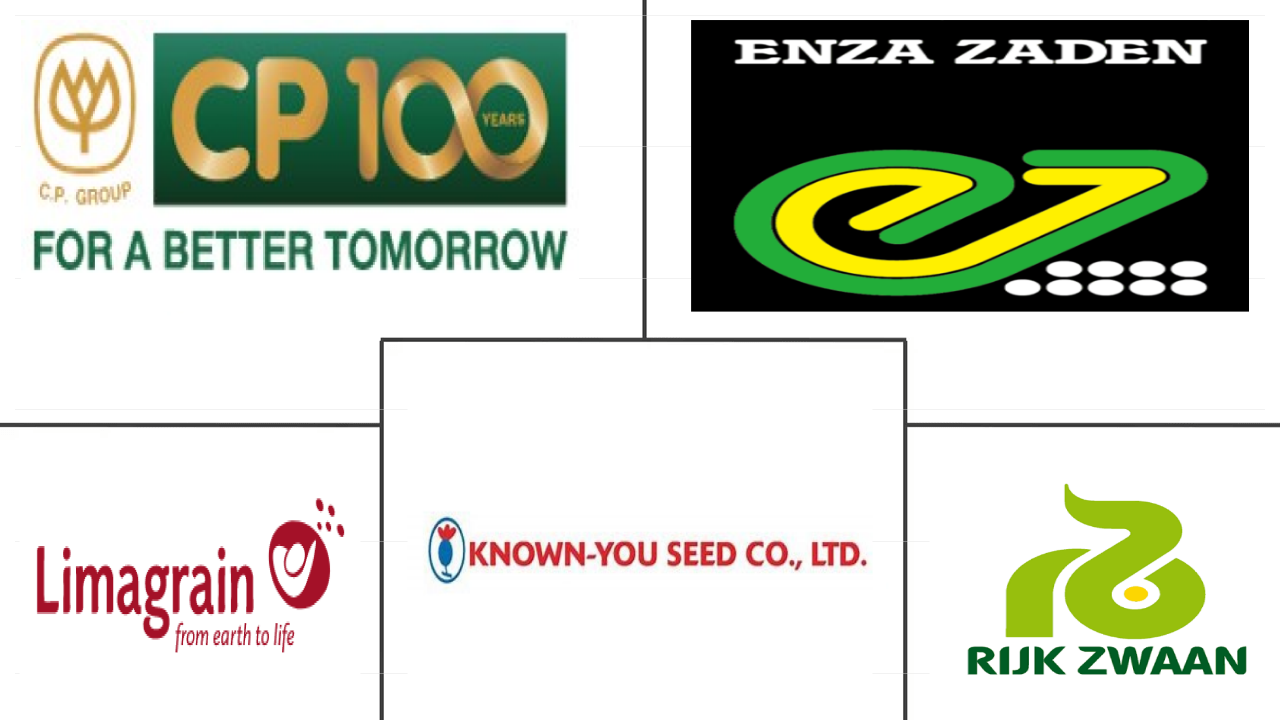Market Size of myanmar seed Industry
|
|
Study Period | 2017 - 2030 |
|
|
Market Size (2024) | USD 227.3 Million |
|
|
Market Size (2030) | USD 298.9 Million |
|
|
Largest Share by Breeding Technology | Hybrids |
|
|
CAGR (2024 - 2030) | 4.67 % |
|
|
Fastest Growing by Breeding Technology | Hybrids |
Major Players |
||

|
||
|
*Disclaimer: Major Players sorted in no particular order |
Myanmar Seed Market Analysis
The Myanmar Seed Market size is estimated at 227.3 million USD in 2024, and is expected to reach 298.9 million USD by 2030, growing at a CAGR of 4.67% during the forecast period (2024-2030).
227.3 Million
Market Size in 2024 (USD)
298.9 Million
Market Size in 2030 (USD)
5.40 %
CAGR (2017-2023)
4.67 %
CAGR (2024-2030)
Largest Market by Crop Family
25.90 %
value share, Grains & Cereals, 2023
Rice and corn are the major crops cultivated in the country. Rice is the major staple food crop grown throughout the country, and corn has a high seed replacement rate.
Largest Market by Breeding Technology
73.22 %
value share, Hybrids, 2023
The high share of hybrids is due to the increasing area under hybrids in crops like corn, sunflower, cotton, vegetables, and others and their high-yielding and disease-resistance traits.
Fastest-growing Market by Crop Family
5.47 %
Projected CAGR, Fiber Crops, 2024-2030
It is the fastest growing due to the rising demand from the textile industry and growing government support in investing in cotton seed research, contributing to the market growth.
Fastest-growing Market by Breeding Technology
4.69 %
Projected CAGR, Hybrids, 2024-2030
The rapid growth of hybrids is associated with characteristics such as high yield, biotic and abiotic stress resistance, high vigor, and early bearing in vegetables.
Leading Market Player
3.14 %
market share, Groupe Limagrain, 2022

It is the market leader in the country with its multi-brand partnership strategy, which allows it to offer a much wider and more diversified variety of crops.
Hybrids occupy the major share of the market with increasing demand from farmers for higher yield
- In Myanmar, hybrid seeds dominate the seed market, which accounted for USD 151.5 million in 2022. In 2022, row crops accounted for 75.1%, whereas vegetables accounted for 24.9% of the hybrid seed market in the country.
- Hybrids have higher productivity, wider adaptability, and a high degree of resistance to biotic and abiotic stresses. For instance, in cotton, hybrids give 50% more yield than conventional varieties. The wider adaptability of hybrids is mainly due to their high buffering capacity to environmental fluctuations.
- The non-availability of transgenic varieties in all the crops, 100% seed replacement rate for every season, the threat to food security due to increasing population, and resistance to biotic and non-biotic stresses are the factors expected to drive the market for non-transgenic hybrids with a CAGR of 4.7% during the forecast period.
- In Myanmar, the open-pollinated varieties seed market is projected to register a CAGR of 4.6% during the forecast period because of the low cost, high adoption to local conditions, low input requirement, and timely non-availability of hybrids in all the crops.
- The only trait approved for commercial cultivation in Myanmar is insect resistance (IR) in cotton only, and 100% of the area under transgenic cotton is insect resistant due to its high yield and resistance to major cotton pests. Therefore, the demand for insect-resistant cotton hybrids is projected to grow with a CAGR of 5.5% during the forecast period in the country.
- Therefore, the high-yielding characteristics of hybrids, along with their wider adaptability and the demand for insect-resistant varieties, are estimated to drive commercial seed usage in the country during the forecast period.
Myanmar Seed Industry Segmentation
Hybrids, Open Pollinated Varieties & Hybrid Derivatives are covered as segments by Breeding Technology. Open Field, Protected Cultivation are covered as segments by Cultivation Mechanism. Row Crops, Vegetables are covered as segments by Crop Type.
- In Myanmar, hybrid seeds dominate the seed market, which accounted for USD 151.5 million in 2022. In 2022, row crops accounted for 75.1%, whereas vegetables accounted for 24.9% of the hybrid seed market in the country.
- Hybrids have higher productivity, wider adaptability, and a high degree of resistance to biotic and abiotic stresses. For instance, in cotton, hybrids give 50% more yield than conventional varieties. The wider adaptability of hybrids is mainly due to their high buffering capacity to environmental fluctuations.
- The non-availability of transgenic varieties in all the crops, 100% seed replacement rate for every season, the threat to food security due to increasing population, and resistance to biotic and non-biotic stresses are the factors expected to drive the market for non-transgenic hybrids with a CAGR of 4.7% during the forecast period.
- In Myanmar, the open-pollinated varieties seed market is projected to register a CAGR of 4.6% during the forecast period because of the low cost, high adoption to local conditions, low input requirement, and timely non-availability of hybrids in all the crops.
- The only trait approved for commercial cultivation in Myanmar is insect resistance (IR) in cotton only, and 100% of the area under transgenic cotton is insect resistant due to its high yield and resistance to major cotton pests. Therefore, the demand for insect-resistant cotton hybrids is projected to grow with a CAGR of 5.5% during the forecast period in the country.
- Therefore, the high-yielding characteristics of hybrids, along with their wider adaptability and the demand for insect-resistant varieties, are estimated to drive commercial seed usage in the country during the forecast period.
| Breeding Technology | ||||||
| ||||||
| Open Pollinated Varieties & Hybrid Derivatives |
| Cultivation Mechanism | |
| Open Field | |
| Protected Cultivation |
| Crop Type | |||||||||||||||||||||||||||||||
| |||||||||||||||||||||||||||||||
|
Myanmar Seed Market Size Summary
The Myanmar seed market is experiencing a steady growth trajectory, driven by the increasing demand for hybrid seeds, which dominate the market due to their higher productivity and adaptability. The market is characterized by a significant focus on row crops, with rice and maize being the major staples, alongside a growing interest in oilseeds and vegetables. The adoption of hybrid seeds is propelled by their resistance to biotic and abiotic stresses, which is crucial for enhancing agricultural productivity in the face of environmental challenges. The market is also witnessing a shift towards insect-resistant varieties, particularly in cotton, which is the only transgenic crop approved for commercial cultivation in the country. This shift is expected to bolster the demand for high-yielding and resilient seed varieties, contributing to the overall expansion of the seed market in Myanmar.
The seed market in Myanmar is fragmented, with several key players such as Charoen Pokphand Group, Enza Zaden, and Rijk Zwaan actively participating in the market. These companies are introducing new seed varieties with enhanced traits, including disease resistance and quality attributes, to meet the evolving demands of the agricultural sector. The vegetable seed market is anticipated to grow as companies develop varieties with improved resistance to viruses and better adaptability to local conditions. The strategic acquisitions and product launches by major players further underscore the dynamic nature of the market, aiming to enhance their product portfolios and cater to the diverse needs of farmers. As a result, the seed market in Myanmar is poised for continued growth, supported by the increasing cultivation area and the rising demand for innovative seed solutions.
Myanmar Seed Market Size - Table of Contents
-
1. MARKET SEGMENTATION (includes market size in Value in USD, Forecasts up to 2030 and analysis of growth prospects)
-
1.1 Breeding Technology
-
1.1.1 Hybrids
-
1.1.1.1 Non-Transgenic Hybrids
-
1.1.1.2 Transgenic Hybrids
-
1.1.1.2.1 Insect Resistant Hybrids
-
-
-
1.1.2 Open Pollinated Varieties & Hybrid Derivatives
-
-
1.2 Cultivation Mechanism
-
1.2.1 Open Field
-
1.2.2 Protected Cultivation
-
-
1.3 Crop Type
-
1.3.1 Row Crops
-
1.3.1.1 Fiber Crops
-
1.3.1.1.1 Cotton
-
1.3.1.1.2 Other Fiber Crops
-
-
1.3.1.2 Forage Crops
-
1.3.1.2.1 Alfalfa
-
1.3.1.2.2 Forage Corn
-
1.3.1.2.3 Forage Sorghum
-
1.3.1.2.4 Other Forage Crops
-
-
1.3.1.3 Grains & Cereals
-
1.3.1.3.1 Corn
-
1.3.1.3.2 Rice
-
1.3.1.3.3 Sorghum
-
1.3.1.3.4 Wheat
-
1.3.1.3.5 Other Grains & Cereals
-
-
1.3.1.4 Oilseeds
-
1.3.1.4.1 Canola, Rapeseed & Mustard
-
1.3.1.4.2 Soybean
-
1.3.1.4.3 Sunflower
-
1.3.1.4.4 Other Oilseeds
-
-
1.3.1.5 Pulses
-
-
1.3.2 Vegetables
-
1.3.2.1 Brassicas
-
1.3.2.1.1 Cabbage
-
1.3.2.1.2 Carrot
-
1.3.2.1.3 Cauliflower & Broccoli
-
1.3.2.1.4 Other Brassicas
-
-
1.3.2.2 Cucurbits
-
1.3.2.2.1 Cucumber & Gherkin
-
1.3.2.2.2 Pumpkin & Squash
-
1.3.2.2.3 Other Cucurbits
-
-
1.3.2.3 Roots & Bulbs
-
1.3.2.3.1 Garlic
-
1.3.2.3.2 Onion
-
1.3.2.3.3 Potato
-
1.3.2.3.4 Other Roots & Bulbs
-
-
1.3.2.4 Solanaceae
-
1.3.2.4.1 Chilli
-
1.3.2.4.2 Eggplant
-
1.3.2.4.3 Tomato
-
1.3.2.4.4 Other Solanaceae
-
-
1.3.2.5 Unclassified Vegetables
-
1.3.2.5.1 Asparagus
-
1.3.2.5.2 Okra
-
1.3.2.5.3 Peas
-
1.3.2.5.4 Other Unclassified Vegetables
-
-
-
-
Myanmar Seed Market Size FAQs
How big is the Myanmar Seed Market?
The Myanmar Seed Market size is expected to reach USD 227.28 million in 2024 and grow at a CAGR of 4.67% to reach USD 298.94 million by 2030.
What is the current Myanmar Seed Market size?
In 2024, the Myanmar Seed Market size is expected to reach USD 227.28 million.

